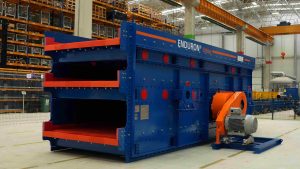With the growing popularity and versatility of fibres in concrete, CHRYSO works with local fibre specialist Oxyfibre to offer customers a professional technical design service. This relates to custom applications of CHRYSO Macro polypropylene fibres, which are considered as structural elements in construction.
Izak Louw, operations manager at Oxyfibre, explains that CHRYSO Macro polypropylene fibres compete with the conventional steel mesh as a reinforcement for concrete. As such, these macrofibres are considered as structural elements, and must pass stringent tests to prove the strength and integrity of their physical properties.
“This creates the basis for us to offer a specialised engineering design service for the application of our macrofibres, not only for ground supported slabs but also for precast concrete,” says Louw. “We use the customer’s data on loadings, ground conditions and the kind of activities that will be carried out on the concrete surface – such as rolling loads and racking loads.”
CHRYSO Southern Africa has been the official distributor for Oxyfibre since 2016, with the two firms having built a strong working relationship for many years before that. Oxyfibre makes available both microfibres and macrofibres supplied by Adfil Construction Fibres, who Oxyfibre represents in sub-Saharan Africa. ADFIL Construction Fibres bases its manufacturing facilities – as well as its research and development laboratory – in Belgium.
“Most of our customised fibre designs relate to civil engineering applications, such as roads and industrial slabs,” he says. “However, we also provide the design service in smaller contracts for driveways, residential homes and requirements on farms.”
Working closely with CHRYSO, the Oxyfibre engineering team considers the customer’s needs and provides feedback on aspects like fibre dosage, the size of saw-cuts on a slab and the optimal thickness of the concrete. A good example of the fibre design offering was for a building project where the contractor was looking for an innovative solution.
“The building had a large number of service conduits to be installed between the hollow core planks and the structural topping,” he says. “It was clear that there would not be enough space to use conventional steel mesh reinforcement.”
The contractor asked CHRYSO and Oxyfibre to find a solution that would allow space to install the service conduits and prevent cracking of the topping’s surface. The use of macrofibres did the trick, also saving on the time and cost of placing steel mesh reinforcement. Moreover, the fibres could be added to the concrete mix at the readymix plant, so there was no need for the storage or mixing in of fibres on site.
“With our tailored design service, we work closely with the customer to supply the required calculations and technical specifications,” he says. “We also produce a detailed commercial proposal that sets out the benefits of CHRYSO Macro fibres; our service comes with professional indemnity.”






